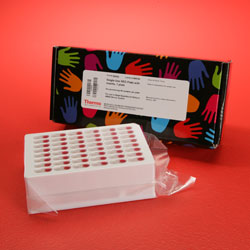北京爱博瑞科科贸有限公司
地址:北京市海淀区彰化路138号
服务热线:189 1158 5263
服务热线:186 0088 7796
点击我及时沟通QQ :1109898866


The Thermo Scientific Pierce RED Device for Rapid Equilibrium Dialysis provides the easiest, fastest and most reliable system for performing plasma protein-binding assays, a critical step in drug development. The Pierce Device for rapid equilibrium dialysis (RED) was developed in association with the pharmaceutical industry to provide the easiest, fastest and most reliable system for performing plasma protein-binding assays. The RED Device is an apparatus for performing equilibrium dialysis experiments in a high throughput, automation-compatible format. The RED device consists of disposable inserts and a base plate formatted to a standard microplate footprint. The RED Device has been extensively validated for plasma-binding assays and produces results consistent with those reported in the literature. The RED Device offers significant improvements in automation, time requirements, versatility and product reliability compared to other commercially available equilibrium dialysis systems. Highlights:
Features of the RED Device Inserts:Each single-use, disposable insert is made of two side-by-side chambers separated by a vertical cylinder of dialysis membrane (in 8K or 12K MWCO) validated for minimal nonspecific binding. This format requires no extensive assembly steps or specialized equipment, and each chamber or well is easily accessible from the top of the insert after insertion in the base plate. Additionally, the high surface-to-volume ratio of the membrane compartment allows rapid dialysis, where equilibrium can be reached in 4 hours with high levels of reproducibility and accuracy. In many cases, experiments can be completed in less than 100 minutes. Insert Features:
Features of the RED Device Base Plates:RED Device Inserts are designed to be used with either the reusable PTFE or disposable high-density polypropylene base plates. Each RED Device Base Plate holds up to 48 RED Device Inserts and has a standard 96-well plate footprint with 9mm x 9mm well spacing to provide compatibility with automated liquid handling systems. In addition, the disposable RED Device Base Plates are available pre-loaded, providing operation convenience for scientists conducting protein-binding applications. No pre-conditioning of the membrane inserts is needed. When using radioactive materials, this single-use plate is easily disposed of to avoid contamination and cleaning. RED Device Inserts and Base Plates are also available separately. Base Plate Features:
Applications:
Product Details:Determining the extent to which a molecule binds to plasma proteins is a critical phase of pharmaceutical development because it influences compound dosing, drug efficacy, clearance rate and potential for drug interactions. This determination is enabled by equilibrium dialysis, an accepted standard method for reliable estimation of the nonbound drug fraction in plasma. Although it is the preferred method, equilibrium dialysis is generally labor-intensive, time-consuming, cost-prohibitive and difficult to automate. The RED Device for rapid equilibrium dialysis was developed in close association with the pharmaceutical industry to specifically address these issues, accelerating lead optimization and reducing the attrition rate. In addition to plasma protein binding, the device is used for determining drug partition between red blood cell and plasma, protein binding of liver microsomes to improve the correlation between in vitro and in vivo intrinsic clearance, the competition between tissue protein binding against plasma proteins and dissociation constant determination (Kd). The RED Device has been extensively validated for plasma-binding assays producing results consistent with those reported in the literature. For example, when used to measure warfarin binding to plasma (human and rat) proteins at two concentrations of 1µM and 10µM, the RED Device produced results with minimal intra-experimental variability. The Rapid Equilibrium Dialysis (RED) Device offers significant improvements in automation, time requirements, versatility and product reliability compared to other commercially available systems.
|
|||||||||||||||||||||||||||||||||||||||||||||||||||||||||||||||||||||||||||||||||||||||||||